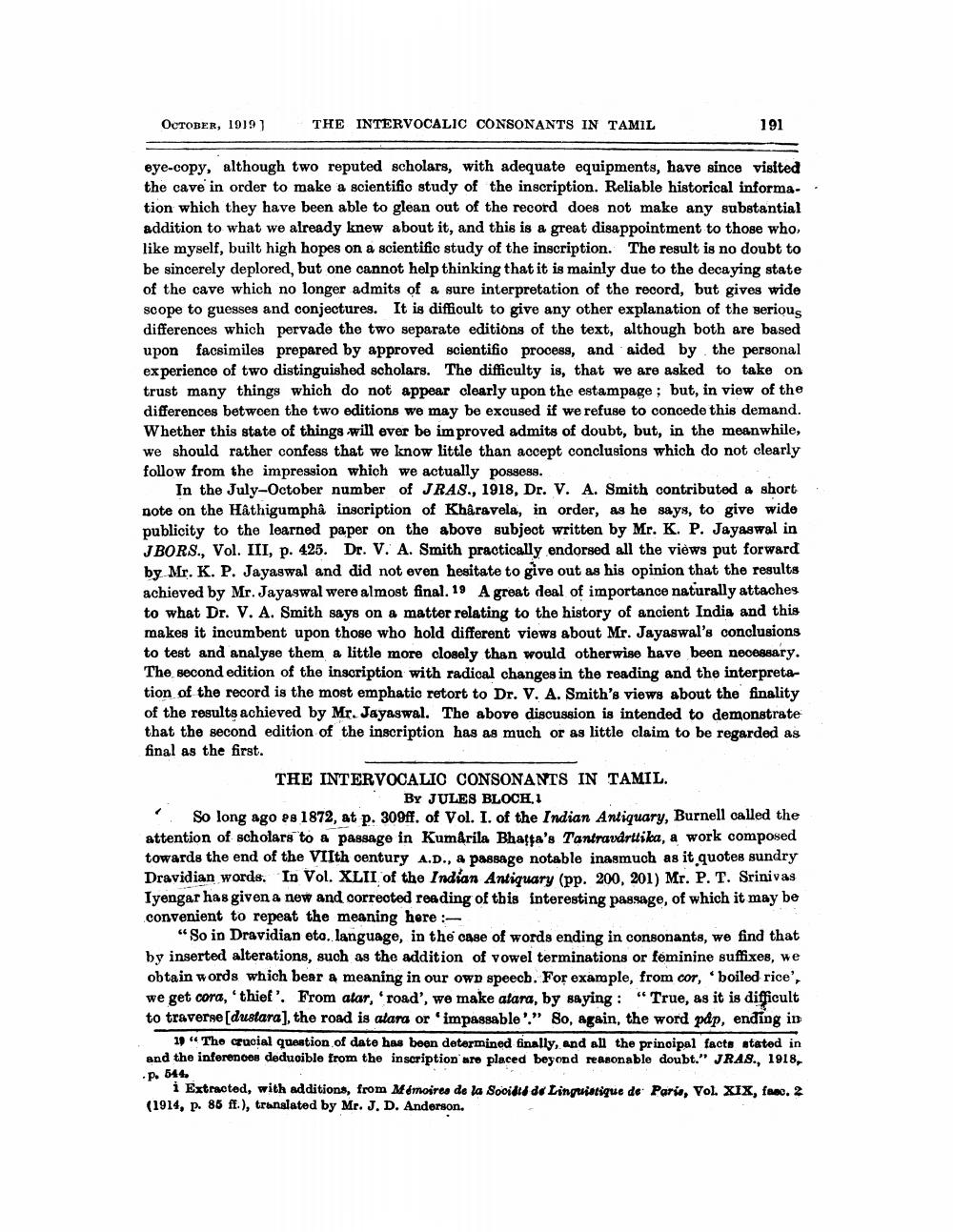________________
OCTODER, 1919)
THE INTERVOCALIC CONSONANTS IN TAMIL
191
eye-copy, although two reputed scholars, with adequate equipments, have since visited the cave in order to make a scientifio study of the inscription. Reliable historical information which they have been able to glean out of the record does not make any substantial addition to what we already knew about it, and this is a great disappointment to those who, like myself, built high hopes on a scientific study of the inscription. The result is no doubt to be sincerely deplored, but one cannot help thinking that it is mainly due to the decaying state of the cave which no longer admits of a sure interpretation of the record, but gives wide scope to guesses and conjectures. It is difficult to give any other explanation of the serious differences which pervade the two separate editions of the text, although both are based upon facsimiles prepared by approved scientifio process, and aided by the personal experience of two distinguished scholars. The difficulty is, that we are asked to take on trust many things which do not appear clearly upon the estampage ; but, in view of the differences between the two editions we may be excused if we refuse to concede this demand. Whether this state of things will ever be improved admits of doubt, but, in the meanwhile, we should rather confess that we know little than accept conclusions which do not clearly follow from the impression which we actually possess.
In the July-October number of JRAS., 1918, Dr. V. A. Smith contributed a short note on the Hâthigumphâ inscription of Khâravela, in order, as he says, to give wide publicity to the learned paper on the above subject written by Mr. K. P. Jayagwal in JBORS., Vol. III, p. 425. Dr. V. A. Smith practically endorsed all the views put forward by Mr. K. P. Jayaswal and did not even hesitate to give out as his opinion that the results achieved by Mr. Jayagwal were almost final. 19 A great deal of importance naturally attaches to what Dr. V. A. Smith says on a matter relating to the history of ancient India and this makes it incumbent upon those who hold different views about Mr. Jayaswal's conclusions to test and analyse them a little more closely than would otherwise have been necessary. The second edition of the inscription with radical changes in the reading and the interpretation of the record is the most emphatic retort to Dr. V. A. Smith's views about the finality of the results achieved by Mr. Jayaswal. The above discussion is intended to demonstrate that the second edition of the inscription has as much or as little claim to be regarded as final as the first. THE INTERVOCALIO CONSONANTS IN TAMIL.
BY JULES BLOCH, 1 So long ago es 1872, at p. 309ff. of Vol. I. of the Indian Antiquary, Burnell called the attention of scholars to a passage in Kum&rila Bhagya's Tantravdrttika, a work composed towards the end of the VIIth oentury A.D., a passage notable inasmuch as it quotes sundry Dravidian words. In Vol. XLII of the Indian Antiquary (pp. 200, 201) Mr. P. T. Srinivas Iyengar has given a new and corrected reading of this interesting passage, of which it may be convenient to repeat the meaning here :
"So in Dravidian eto. language, in the case of words ending in consonants, we find that by inserted alterations, such as the addition of vowel terminations or feminine suffixes, we obtain words which bear a meaning in our own speech. For example, from cor, 'boiled rice', we get cora, 'thief'. From atar, 'road', we make atara, by saying: "True, as it is difficult to traverne [dustara], the road is atara or impassable!." 80, again, the word pdp, ending in
19 "The crucial question of date has been determined finally, and all the principal facts stated in and the inferences deducible from the inscription are placed beyond reasonable doubt." JRAS., 1918,
.P. 644.
i Extracted, with additions, from Mémoires de la Sooided do Linguistique de Paris, Vol. XIX, fasc. (1914, p. 86 ff.), translated by Mr. J. D. Anderson.




